Tui Teddy's grade every year becomes more and more popular and more popular in landscape design. Such success of evergreen shrub is explained by the presence of highly decorative qualities of perennials conjugate with minimal departure and endurance of the Tui.
The unique shape of a soft velvet ball will not leave even the sorting gardener indifferent. In addition to other advantages, the dwarf evergreen shrub is a real long-liver and is able to grow in one place to 100-150 years. All this time, the culture will not only please their original appearance, but also to exude healing phytoncides, cleaning air.
In today's article - all about landing and caring for Taydu Teddy, the features of reproduction and the secrets of successful cultivation of many years of culture in the open soil.
Tuya Teddy, plant description
Thuja Teddy is a highly decorative evergreen shrub of a spherical shape. This is a relatively young dwarf grade, the progenitor of which is the famous type of Tui Western from the cypress family. Often, you can find the unifying name "Tuya Western Teddy". Externally dense soft bushes resemble Teddy's teddy bear, which was displayed in the full name of the hybrid.
- North America is considered to be a homeland culture. In Europe, they took a long time ago, from 1540. After that, the selection of new varieties and hybrids of evergreen plants tirelessly gained "turns".
- The name of the culture "Thuja" in translation denotes "anonymous", which is associated with a coniferous aroma, obtained by burning wood in the time of ancient rites. Western Tyu is called a "vital tree".
- Thuja Teddy is a slight slow-growing plant that adds no more than 2-3-cm per year. The height of the adult bush at the age of 10 years will not exceed 50 cm.
- Numerous fine young shoots that make up a thick spherical crown, firmly fit to each other.
- Savages thick covered with soft needles. With age, the leaves acquire the type of scales. Blue-green foliage in the autumn-winter period can slightly yellow or acquire a bronze tint. The needles are updated every 2-3 years during the windfall (along with small twigs).
- The crust in perennial smooth, wood soft, but durable.
- A branched root system is characterized by a superficial arrangement, which is important to consider when leaving the perennial.
- The minor cones of Tui Teddy are covered with thin scales, which reliably protect the seeds of culture.
- Tuya Western Teddy grows perfectly in the open soil or in containers, effectively decorating garden paths, mountaineering, lawns, parks, etc.
- The unique form of the crown does not require forming trimming, which is important advantage and so unpretentious in many respects of culture.
- Thuja, like other representatives of the cypress family, highlights the beneficial flavoring essential oils that contribute to the purification of air.
- Due to spectacular appearance, durability and unpretentiousness, the plant is widespread in the field of decorative gardening. Small compact green thuly balls capable of decorating any corner of a park or garden.
Taude Teddy, landing features
In order for evergreen shrub, a long time pleased with its grace and originality, it is important to initially choose the place for landing. In addition to decorative landscape destinations, each plant, including Thu Teddy, has biologically reasonable preferences and requirements that it is important to take into account when landing a durable culture.
Place for landing Tui Teddy
- Sun-tee thuja prefers well-lit terrain or light half. The perfect option is when the sun's rays will be slightly scattered and indirect, which will avoid unwanted burning of the conifers of the Tui. The shadow is also not suitable, since then the thua will lose its valuable decorative qualities: the elongated fatigue shoots will not be able to form such a dense and beautiful spherical shape of the crown. The shrub will look neakkuptant and neglected.
- When choosing a place for landing evergreen, a ball thuua should pay attention to the so-called. "Rose winds." Shrub must be protected from direct drafts and strong winds, especially from the northwestern side.
- Thuja Teddy is a stray and unpretentious plant, which can grow almost on any types of soil. It is better if the soil is drained, loose and moderately wet. Heavy tight soil will negatively affect the development of a shrub.
- As for humidity, there should be no water during the landing site during the rain or melting of snow. The terrain with a slight bias or a small soil elevation is well suited.
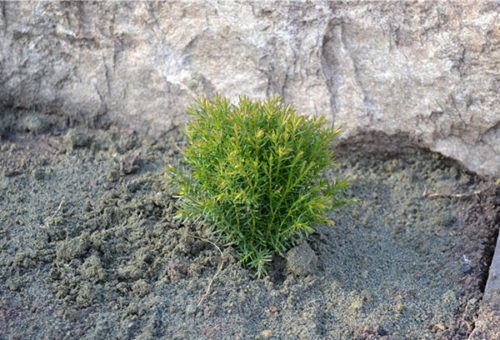
Tia Teddy Time
- Saplings with a closed root system are planted into open ground, starting from April and ending with October, depending on the region and its climatic conditions.
- No container seedlings (with an open root system) are planted into the ground in the second half of spring or the first half of autumn, like most other thermo-loving plants.
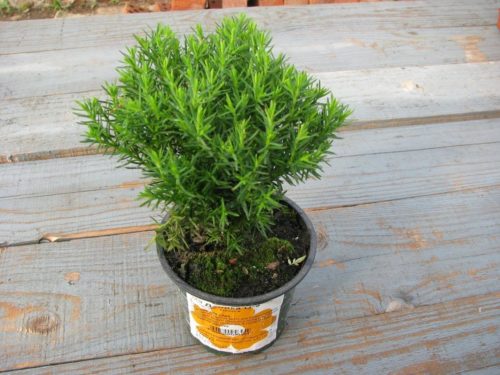
Agrotechnology landing Tui Teddy
- The landing pit is preparing, exceeding the size of the container with a seedliness of about 2 times.
- In order to protect a long-term shrub from moisture stagnation, especially in the conditions of a close occurrence of groundwater and the heavy structure of the soil, it is important to ensure the presence of a drainage layer. To do this, there are broken bricks, crumbs or gravel, with a thickness of about 20-30 cm.
- After the drain layer, the pit on 2 \\ 3 is falling asleep with a nutrient soil from equal parts of the turf, peat and sand. With the scarce composition of the soil, it is recommended to add a complex mineral or organic fertilizer (compost, humid, wood ash). Fresh manure is known to use for plant fertilizer. Taude Teddy is positively responding to high fertile soils.
- Soil fertilizers are slightly seal and spilled abundantly with water.
- Landing in open ground is usually carried out by seedlings grown in containers. In order not to damage the roots, the plant is abundantly watered over a day before the transplant, after which it is easily removed from the pot together with an earthen room.
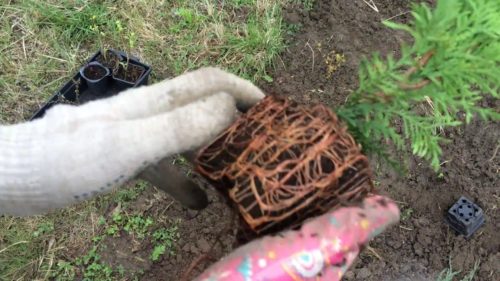
- Exposing the roots of a seedling in the landing pit, you should focus on the location of the root cervix. The correct landing scheme provides for the foundation of the root cervix at the level of the ground surface. Therefore, if necessary, the missing amount of soil is being added to the pit.
- The Tui landing site is slightly covered in order to avoid the formation of voids and spill water.
- The rolling circle is mounted peat, beveled grass or wood bark. Mulching material not only retains the optimal level of humidity, but also prevents the appearance of weed herb.
- The distance between the tui bushes is kept on the basis of the size of the crown forming in the future, which in diameter will not exceed 40-50 cm.
- When buying Tuya Teddy's seedlings, it is important to pay attention to the roots to be not cutting (with an open root system), and the bark did not have it. Soothes from a seedling must be not damaged or fading.
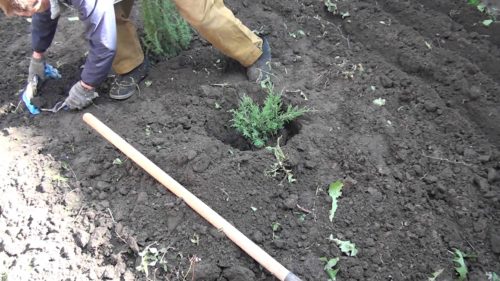
Tuya Teddy, plant care
The cultivation of Tui Teddy does not require special knowledge or skills, it is enough to perform standard agrotechnic techniques for the care of the plant so that the perennial can fully grow and develop. Such agro receptions belongs to watering, loosening, feeding and the shelter of the shrub for the winter.
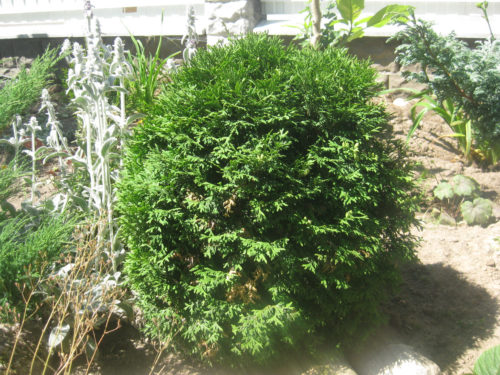
Watering and mulching Tui Teddy
- The moisture thua is poorly tolerates dry dehydrated soil. This is due to the large number of evaporated moisture, which the plant needs to be constantly replenished.
- At first, after landing, watering plays a decisive role in the process of seeding. Watering a young plant is necessary as the soil drying.
- The average irrigation rate is considered to be a weekly abundant wetting of a shrub of 8-10 liters of water. With arid weather, the amount of irrigation can reach 2-3 times a week.
- Tuya Teddy has a beneficial response to the crown sprinkle. Regular helium irrigation provides perennials bright, juicy needles and fresh coniferous flavor. Dry air negatively affects the appearance of the decorative plant. Raintenance is carried out in the morning or in the evening, several times a week.
- The lack of moisture is reflected in the appearance of the evergreen Tui: Krona shrub begins to shut up and noticeably rarely.
- After irrigation, the priority circle is better to climb. The peat, compost, wood bark, chip or beveled grass fit as mulch. Painted chips will also perform an additional, decorative function.
- Mulching will avoid the need for constant loosening and weeding. In addition, the mulch delays moisture, keeping the as long as possible the necessary soil microclimate. With the mulching of the priority circle, the frequency of watering is reduced.
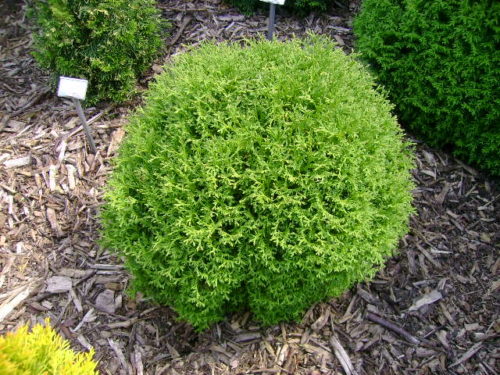
Loosening and weeding Tui Teddy
- If the soil near the roots of the Tui is not closed, the shrub needs regular loosening after each watering or rain.
- Ruff soil must be carefully and shallow, taking into account the surface running of the roots of the Tui. Damaged roots will cause drying the shoots of shrub.
- The care of the Thuy includes a weeds tool so that the wild grass does not oppress the development of a dwarf tui and not "taken" nutrients from the soil.
Up. Tui Teddy
- The annual one-time feeding in the spring will be enough for the plant to develop "in full force", it looked as attractive and decorative as possible.
- Fertilizers are entered in the first half of spring, in April-May, in the process of irrigation.
- For the fertilizer Tui Teddy, it is recommended to introduce a special mineral complex intended for coniferous species of trees and shrubs. For example, you can use the laminating and low toxic complex "Nutrisol", containing all the necessary for successful growth and development of coniferous crops trace elements: phosphorus, potassium, iron, zinc, magnesium, manganese. It will take about 60 grams dissolved in water fertilizer for each adult bush.
- An alternative substitute for such a complex can be the introduction of spring mineral feeding - nitroammophos, in the amount of 30-40 g per m 2. Then in the fall add an additional dose of potash-phosphoric fertilizers.
- The introduction of vegetable compost or peat soils will also improve meals, and therefore the appearance of many years of evergreen culture.
Trimming Tui Teddy
- The hybrid slow-growing grade, Taudey Thuja, in the process of growth independently forms a spherical form of the crown, so the shrub does not need a shrub in the cardinal forming trimming.
- In early spring, sanitary trimming is carried out, in the process of which broken, dry and too long (knocking out of the shape of the ball) branches are removed. The first sanitary-thinning trim starts after 2 years of growth of a young seedling.
- With sanitary-thinning trimming, it is important not to remove more than 1 \\ 3 parts of a young increase. Over time, the needles inside the crown is partially tremendous, and the needle of dense framing the entire perimeter of the crown.
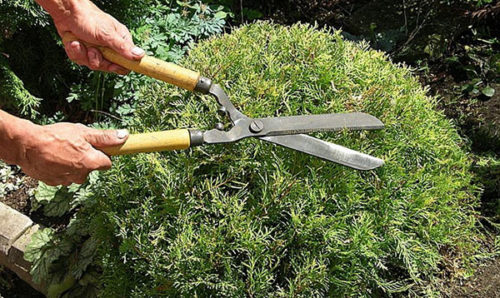
Fighting pests and diseases Toudy Teddy
- Coniferous rocks, including Tui, are practically not subjected to pest attacks and are resistant to various kinds of diseases.
- Possible threats can be fungal diseases (fuzariosis, brown spruce, cytospose), at the first signs of which the plant is treated with appropriate copper-containing fungicides: top or chime. The prevention will suit the system of system action - Fundazol or burglar liquid. In the spring, in order to avoid infection with the infection, the bush is treated with one of the antifungal drugs.
- When the so-called appears on the needles Turning TLA, the plant is treated with insecticides as an actar or decis. After 1-1.5 weeks, repeated spraying.
Preparation for Winter Tui Teddy
- Unpretentious and resistant to unfavorable conditions of the Wednesday Tuya refers to the plant 5th zone of frost resistance.
- Winter-hardy adult plant does not need special shelter in winter. Only 1-3 years old seedlings are needed.
- Late in the fall, young plants are wrapped with agricultural, burlap or sweetheart, and the root zone is sprinkled with a foam, straw or the same pagan. Before it should be released the soil from mulch if there was such a thing.
- In winter, the shrub is additionally sprinkled with snow, but so that the krona is subsequently deformed. Experienced gardeners recommend to bind the shoots of the Tui until they grow and did not acquire the shape of the ball. It is impossible to bind the formed ball-shaped crown, but on the contrary, it is protected from a large mass of snow, setting protective "arches-grid" or wooden frames.
- In the country's dacha forums, engaged in the cultivation of coniferous culture in their sites, note the problem of perennial: Thuja Teddy collapse over time and loses the initial clear view of the ball. This happens in adulthood, especially after the winter, when the shrub was too "littered" with snow cover, after which he could not fully restore the ball like the crown. That is why it is so important to avoid a heavy layer of snow on shrubs. If such a trouble has already happened - it remains to tie a shrub inside and at the base of the crown.
- Spring bright sun can lead to burns of evergreen plants. Therefore, agriched should be removed gradually, imitating the light half until the shrub is completely adapted to the sunshine.
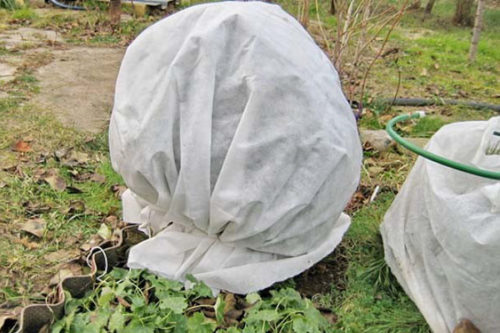
Thuja Teddy, breeding methods
Thuja Teddy multiplies with a vegetative and generative (seed) way. Consider the key features of each of the methods.
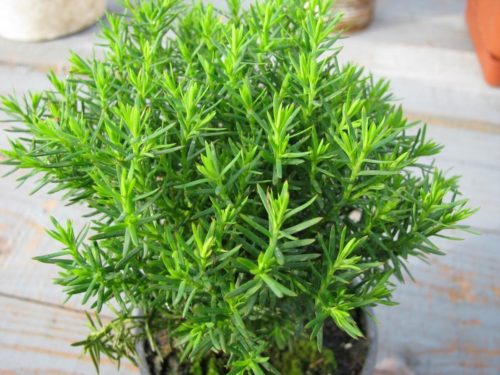
Tuya Teddy, reproduction of seeds
The seed method of reproduction may not retain the varietal signs of the plant. In addition, the reproduction of seeds is a very long and painstaking process (5-6 years). The advantage of the seed method can be called good adaptation of plants and endurance to local growth conditions.
- For sowing, use fresh seeds collected in the fall and past stratification in a refrigeration chamber for 2-3 months.
- To assemble the overwhelmed seeds, in the fall weeping the cones of the Tui and leave them in the warm room. After some time, the bumps themselves are revealed and exempt from seeds.
- Stratified Tui seeds (at the end of winter or at the beginning of spring) are sown in containers with soil from the turf, peat and sand in a 1: 2 ratio: 0.5, respectively. Pre-prepared soil can shed a weak solution of potassium permanganate, disinfecting the soil and destroyable "parasites".
- Blowing the seeds into the soil is necessary for no more than 0.5 cm, sprinkting on top with a thin layer of sand.
- After landing, the soil is moisturized from the spray gun and build a "mini-greenhouse". For this, the container is covered with glass or film.
- The main care for germinating seeds will be in humidification of the soil and ventilation of the greenhouse.
- In the spring, the grown seedlings plant in the open nutritious soil, in a half.
Thuja Teddy, reproduction with cuttings
The reproduction of the vegetative way allows to fully maintain the varietal signs of culture. This method of reproduction is considered simpler and efficient.
- Semi-hydraulic annuals are suitable for cuttings or weathered two-year shoots, which are cut by segments of 20-30 cm. It is also practiced by the use of cuttings with the so-called. "Heel", i.e. With a piece of bark.
- Annual cuttings are harvested at the beginning of summer, two-year, as a rule, in the fall. The lower part of the prepared "segments" is purified from needles, and the cut itself is soaked in a growth stimulator (for example, in heteroacexine). Such manipulation allows you to speed up the process of forming roots.
- The treated cuttings are placed in soil from equal parts of peat, sand and garden land, to a depth of 2 to 4 cm. For disinfection, the mixture is better to rolling in the oven. Landing the cuttings is better to exercise in the container not vertically, but with a slight inclination.
- The container is left indoors, maintaining the temperature there is not lower than 22-23 0C and humidity about 70%. Regular watering, ventilation and gradual hardening of Chenkov are the main conditions for the successful cultivation of Tui seedlings.
- The rooted full cuttings are then searched in separate pots for further reassembly.
Experienced gardeners, except for the shilling, are also practiced by the division of the bush part (technique of balls) or rooting horizontal plants. This technique is more laborious and requires certain skills and skills.
Tuya Teddy, where to buy
If you independently grow a seedling Tui Teddy, you can not buy a shrub in a specialized store or nursery. Moreover, it is possible to get a young seedling and an adult plant with an already formed crown.
When buying should pay attention to the appearance of the plant. A healthy sapling should be with elastic branches that do not shuffle needle, without any stains and yellowness.
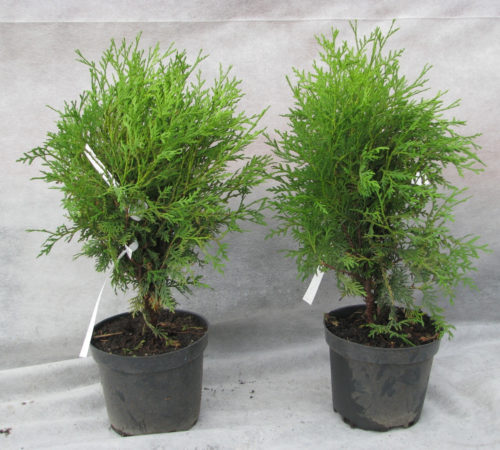
Tuya Teddy in Landscape Design
- Tuya Western Teddy is the perfect version of the designer design of a garden or a park zone. Dwarf variety with an unusually decorative form of crown, in fact, was created for use in landscape design.
- Neat low evergreen balls of Tui are indispensable in rocky gardens, mountaineering or urban squares.
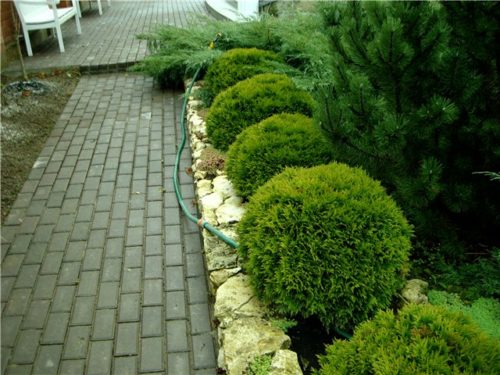
- The original shape of the shrub looks effectively both in single landings and group.
- Thousand Teddy's miniature taou will decorate any corner of a garden or a homeland area. It can be grown not only in the open soil, but also in containers or pots, exposing them near the arbors or terraces.
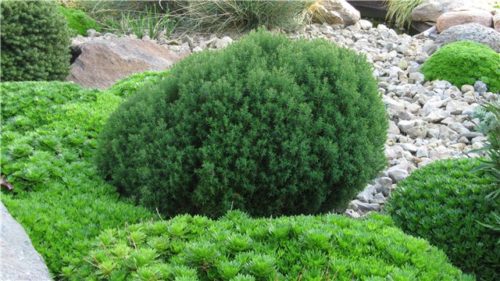
Thus, Thuja Teddy is a beautiful and spectacular decorative plant. The perennial possesses a number of advantages and advantages to grow it in its plot not one dozen years.
Evergreen coniferous shrub is an unpretentious and hardy plant that does not require special care. Thua perfectly tolerates harsh winters, opposes pests and practically does not need trimming. Instead, decorative culture is able to transform any garden, lawn or a household plot. The fabulous form and the exotic appearance of the Teddy Teddy Bears, perhaps, never ceases to amaze and attract the attention of passersby.


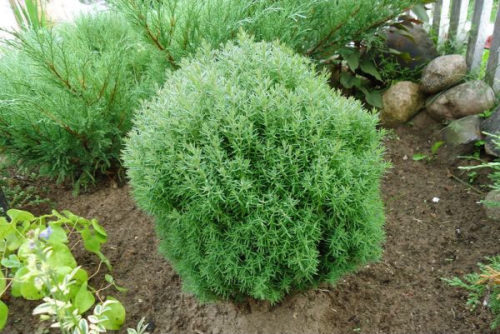
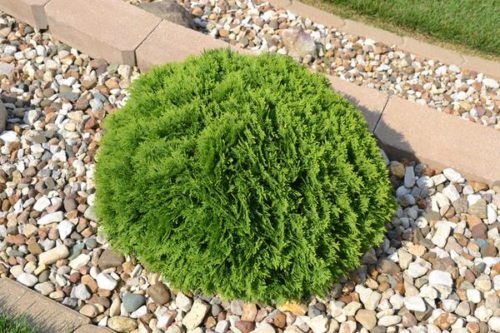
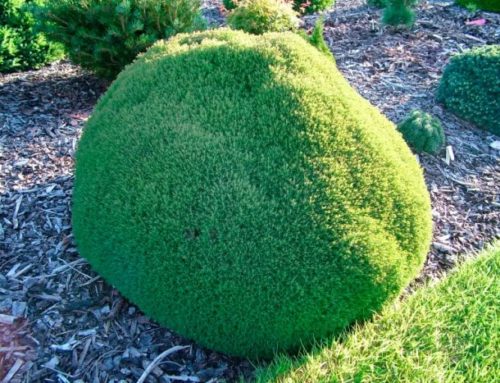
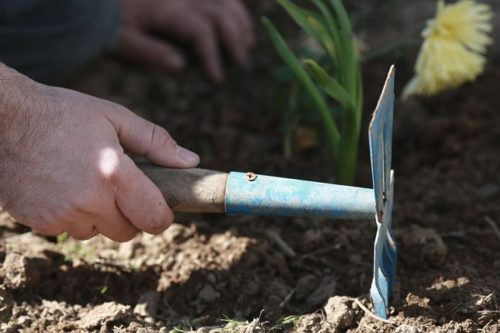
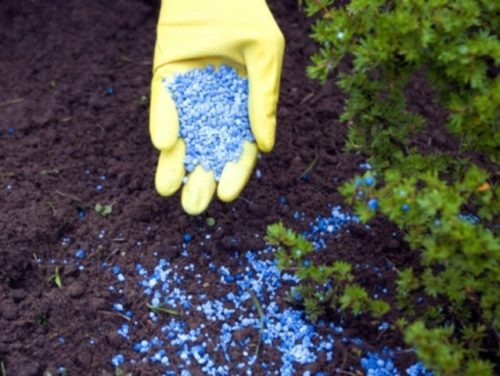
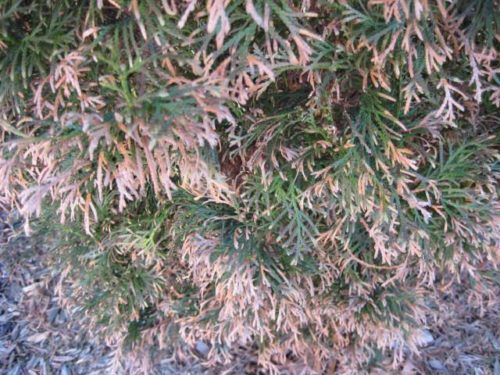
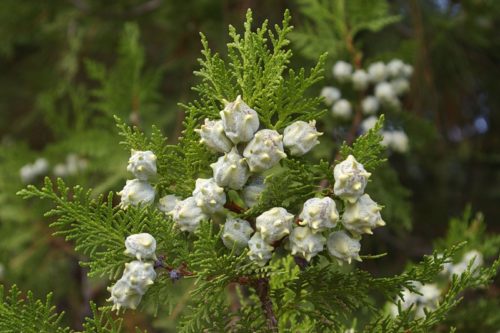
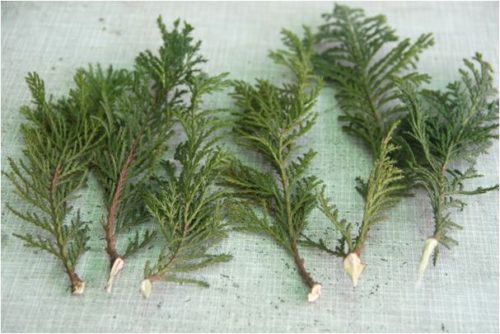
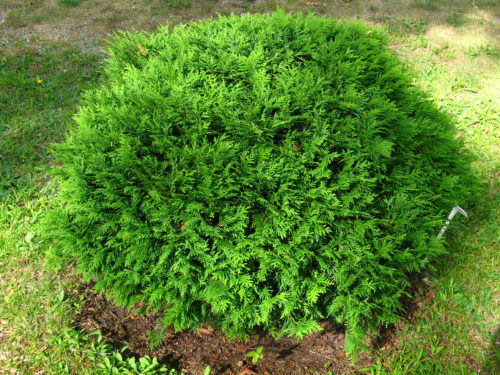
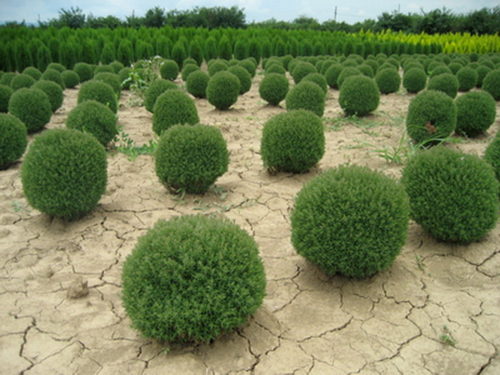
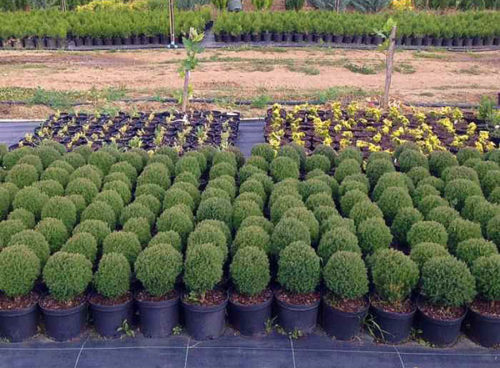
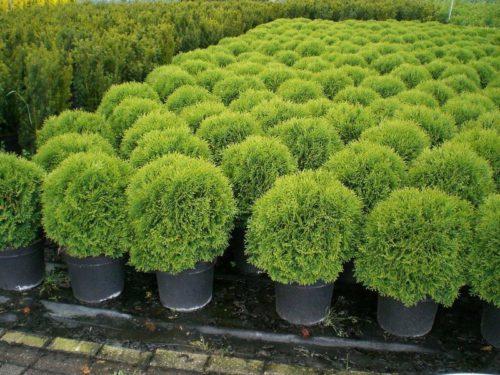












 Start a discussion ...
Start a discussion ...